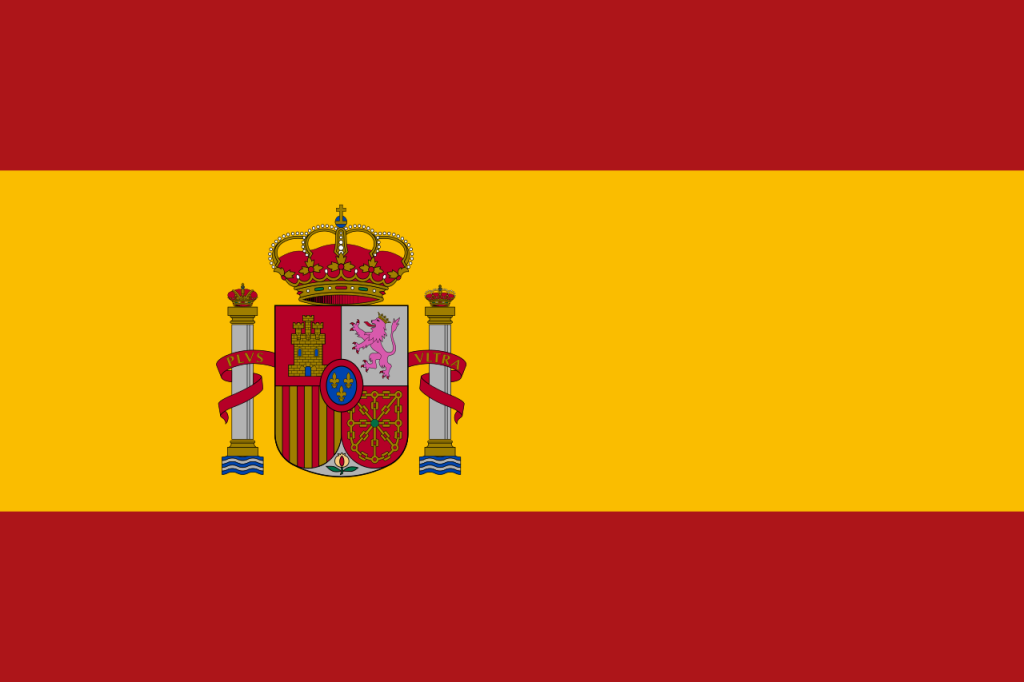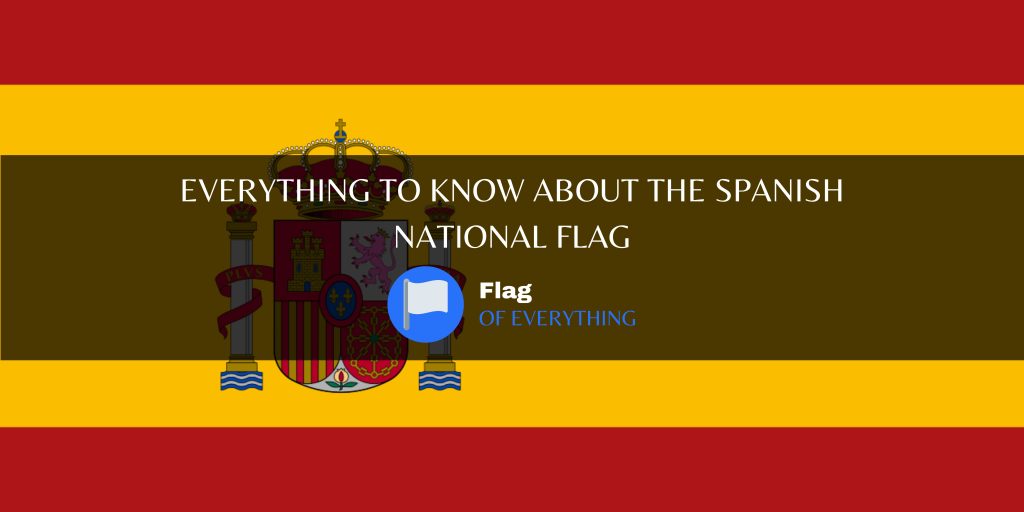The Spanish national flag often called “La Rojigualda”, with its bold red and yellow colors, is a symbol that speaks to Spain’s rich history, culture, and identity. In this exploration, we aim to uncover the meaning and symbolism behind Spain’s flag while addressing common questions regarding its name and historical variations.
The Spanish national flag consists of three horizontal bands of red, yellow, and red, with the national coat of arms on the yellow band toward the hoist side. The coat of arms features a complex arrangement of symbols, including pillars, a crown, and various shields, which represent Spain’s historical regions and kingdoms. It is a symbol of Spain’s unity, heritage, and diversity.
Both “Spain flag” and “Spanish flag” are commonly used terms to refer to the national flag of Spain. The flag is officially known as “Bandera de España” in Spanish, which translates to “Flag of Spain.”
Spain has never officially included purple in its national flag. The flag has traditionally consisted of the colors red and yellow. However, there have been historical variations of flags used by different Spanish entities, some of which included purple elements. These variations are not part of the modern Spanish national flag.
The flag of New Spain, also known as the “Spanish Empire Flag” or the “Flag of the Viceroyalty of New Spain,” was used during the period when Spain had extensive colonial territories in the Americas, including Mexico. It featured the red and yellow colors of Spain, often with the addition of the Spanish coat of arms. This historical flag represented the authority of the Spanish Crown in the New World but is distinct from the modern Spanish national flag.

What is the shape of the spanish national flag?
The Spanish national flag exhibits sharpness and keenness in its design. It consists of three horizontal stripes: red at the top and bottom, with a thick yellow (gold) stripe in the middle. These stripes have well-defined edges, creating a visually striking and easily recognizable symbol of the nation.
The Spanish flag embraces angularity through its rectangular shape and the precise division of its three horizontal stripes. The flag’s sides form right angles, symbolizing order, stability, and adherence to tradition.
The Spanish flag does not display narrowing. Its width remains consistent from top to bottom, maintaining a balanced and harmonious appearance that signifies unity among the regions of Spain.
The Spanish national flag does not prominently incorporate curvature or curves. Its design relies on straight lines and bold color contrasts, which emphasize clarity and simplicity.
The Spanish flag does not emphasize roundness in its design. The flag’s elements, including the bold stripes and the coat of arms, are characterized by angular shapes and sharp contours, reflecting Spain’s straightforward and historic symbolism.
The Spanish flag is characterized by straightness in its shape and the division between its red and yellow horizontal stripes. These straight lines represent Spain’s commitment to order, tradition, and its national identity.
The Spanish flag does not showcase stratification. It consists of three equal horizontal stripes, making it a straightforward and unified design that underscores the importance of national unity and equality among the diverse regions of Spain.
How wide is the spanish national flag?
The width of the Spanish national flag holds a significant dimension, measuring approximately 4.92 feet or 1.5 meters in standard scales. This width allows the flag to be prominently displayed during national events and celebrations, symbolizing Spain’s history, unity, and democratic values.
How high is the spanish national flag?
The height of the Spanish national flag stands at around 3.28 feet or 1 meter in standard scales. This balanced height complements its width, ensuring that the flag’s design is presented with precision and respect, embodying Spain’s commitment to democracy, monarchy, and European integration.
What is the aspect ratio of the spanish national flag?
The Spanish national flag adheres to an aspect ratio of 2:3, creating a harmonious and visually appealing design. This carefully chosen ratio ensures that the flag’s proportions remain faithful to its intended representation, symbolizing Spain’s constitutional monarchy and historical heritage.
What colors does the spanish national flag use?
The spanish national flag has a total of 2 colors: red and yellow(gold). The exact color codes are given in the table below.
| Red | Yellow | |
| HEX | #AA151B | #F1BF00 |
| RGB | 170, 21, 27 | 241, 191, 0 |
| CMYK | 0, 90, 76, 0 | 0, 5, 100, 0 |
| Pantone | 032 | 109 |
| RAL | 3020 | 1023 |
History of the spanish national flag
The history of the Spanish national flag reflects the country’s complex historical journey. The flag’s design, featuring horizontal stripes of red and yellow, is rooted in Spain’s historical connection to the Crown of Aragon and the Kingdom of Castile. Today, it symbolizes Spain’s unity, constitutional monarchy, and commitment to the European Union.
When was the spanish national flag created?
The modern version of the Spanish national flag, with its horizontal stripes of red and yellow, was officially adopted on December 19, 1981, following the approval of the Spanish Constitution of 1978. This date marks a significant moment when Spain embraced a symbol that represents its democratic values and European integration.
Who made the spanish national flag?
The design of the Spanish national flag, with its red and yellow horizontal stripes, has historical roots and was not created by a specific individual. It represents the historical heritage of Spain and its constitutional monarchy.
How much did it cost to create the spanish national flag?
The creation of the Spanish national flag was not associated with a specific monetary cost, as it represents Spain’s historical legacy and commitment to democracy, monarchy, and European cooperation.
What is the meaning of the spanish national flag?
The colors on the spanish national flag encapsulate the nation’s complex history, its determination to overcome adversity, and its commitment to unity and progress. The flag serves as a powerful symbol of modern spanish, embodying the nation’s values and aspirations. The symbols on the spanish national flag and their meanings are shown below.
- Coat of Arms: The Spanish national coat of arms, featured on the yellow band toward the hoist side, is a complex and historic symbol. It includes several elements, such as pillars representing the Pillars of Hercules, a crown symbolizing the monarchy, and various shields and emblems representing Spain’s historical regions and kingdoms. These symbols together convey Spain’s rich heritage, unity, and diversity.
The colors on the spanish national flag and their meanings are shown below.
- Red and Yellow Bands: The Spanish national flag consists of three horizontal bands – two red bands on the top and bottom and a yellow band in the middle. These colors have historic significance. Red symbolizes valor, bravery, and the sacrifices made by the Spanish people throughout their history. Yellow represents generosity and is a symbol of the Spanish nation’s readiness to provide for its citizens and the world.
How to fly the spanish national flag?
The Spanish national flag is flown with great respect and accordance with the nation’s customs and traditions. Proper flag etiquette includes displaying the flag prominently during national holidays and events, as well as raising it briskly and lowering it ceremoniously. The flag’s design represents Spain’s unity and European identity, and its proper display is an embodiment of the nation’s pride and democratic values. The most important etiquette of the spanish flag is described below.
- Positioning: Place the flagpole securely in the ground or on a suitable mounting structure, ensuring that the flag remains visible and unobstructed.
- Orientation: When raising the flag, make sure the red band is at the top, followed by the yellow band in the middle and the red band on the bottom. This arrangement preserves the correct order of the flag’s colors.
- Raising and Lowering: Raise the flag briskly in the morning and lower it ceremoniously at sunset. If you choose to keep it up overnight, ensure it is properly illuminated.
- Respect: Handle the flag with care and avoid letting it touch the ground. It’s a symbol of Spain’s rich heritage and should be treated with respect.
Do spanish citizens respect the spanish national flag?
Yes. spanish citizens do respect the spanish national flag. It symbolizes the nation’s historical heritage and commitment to democracy and European values. Displaying the flag with honor and pride is a testament to the Spanish people’s dedication to unity and constitutional monarchy.
Is the spanish national flag disrespectful?
No, the spanish national flag is not disrespectful. On the contrary, it is a revered symbol of Spain’s historical legacy and commitment to democracy and European integration. Treating the flag with dignity and respect reflects the nation’s values and reverence for its constitutional monarchy and European identity.
What flags are similar to the spanish national flag?
Below are the national flags that resemble the spanish national flag.
- Flag of Colombia: The flag of Colombia includes horizontal bands of yellow, blue, and red. While the colors are similar, the arrangement and design of the Colombian flag differ from the Spanish flag.
- Flag of Belgium: The flag of Belgium consists of vertical bands of black, yellow, and red. Although it shares some colors with the Spanish flag, the arrangement and order of the colors are distinct.

